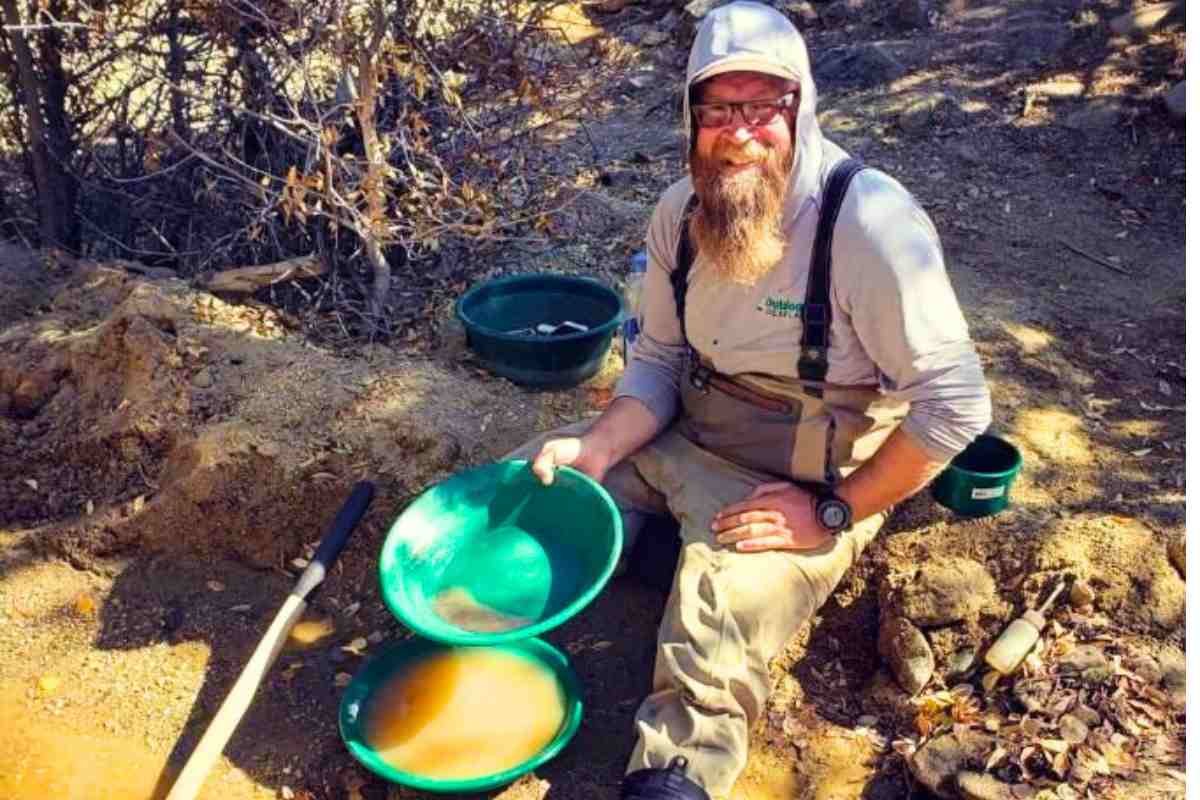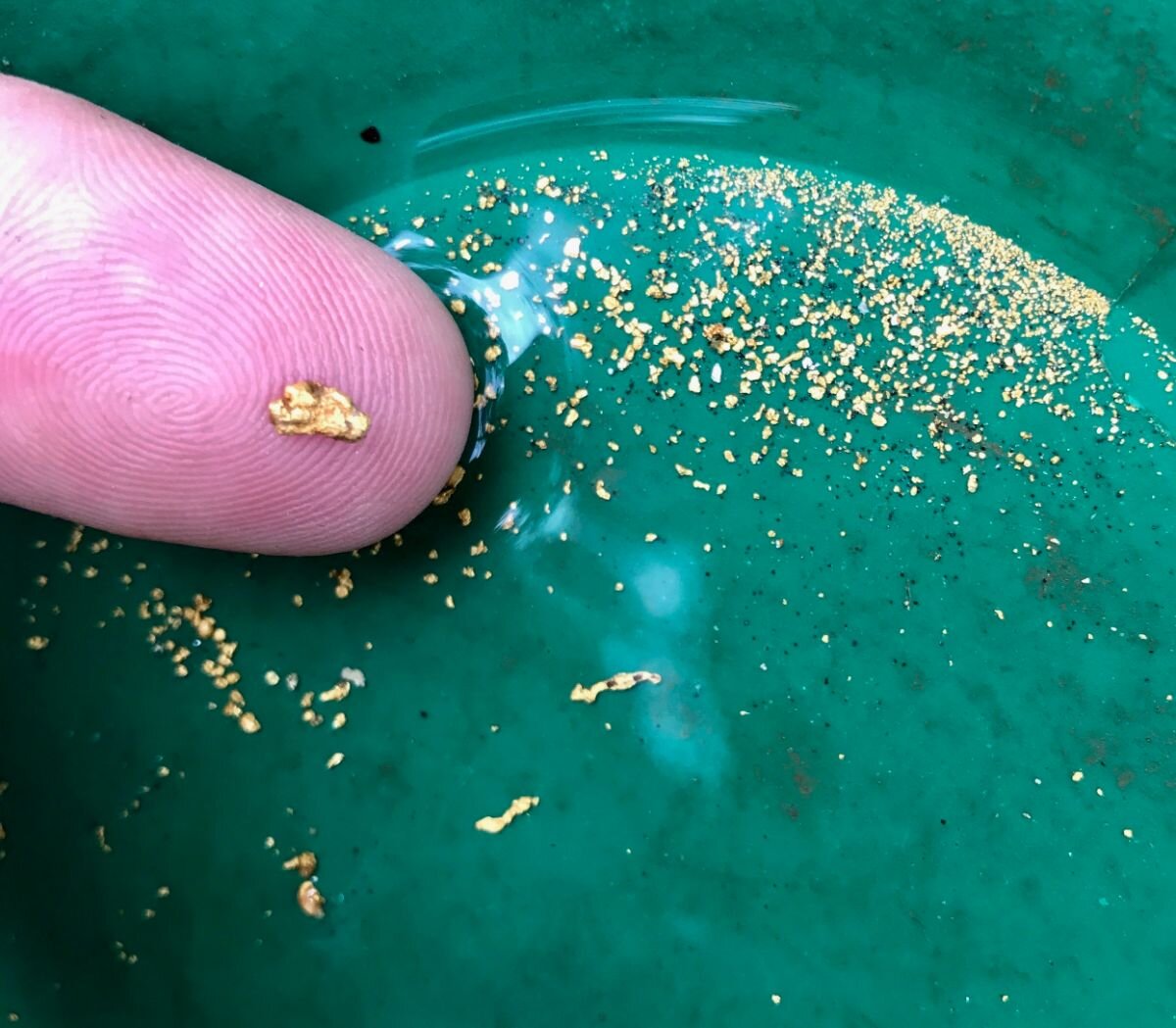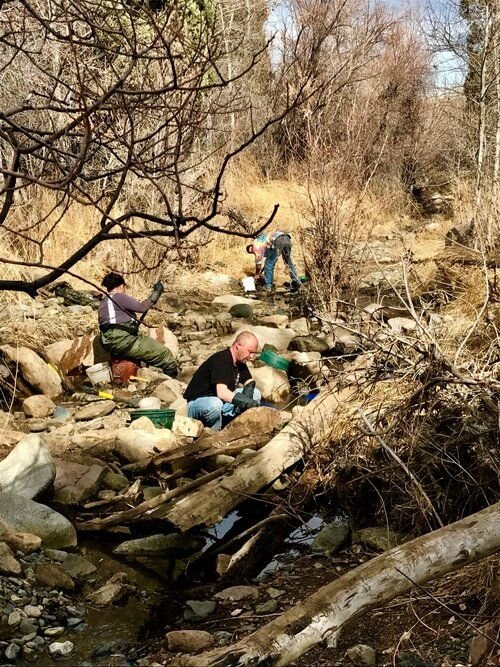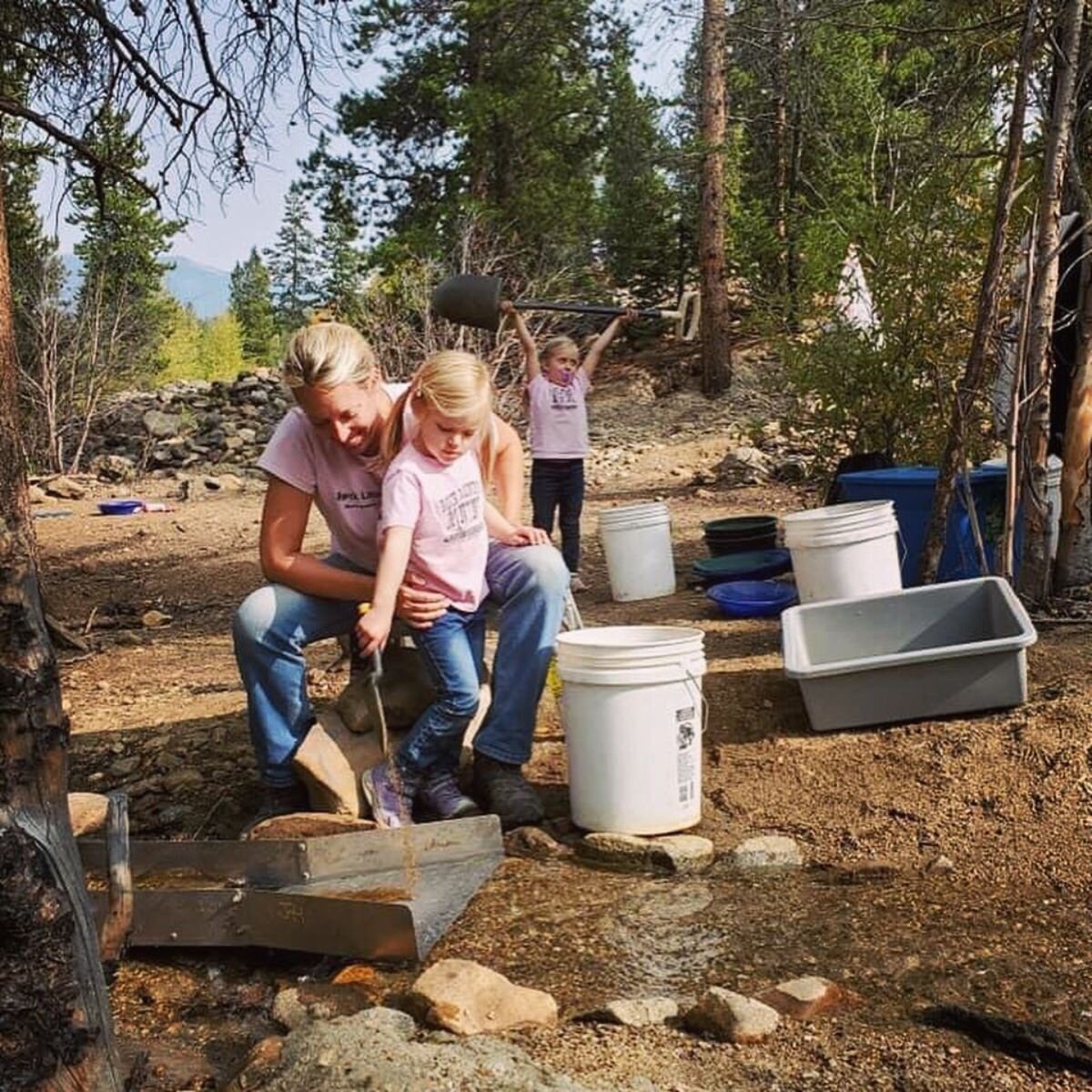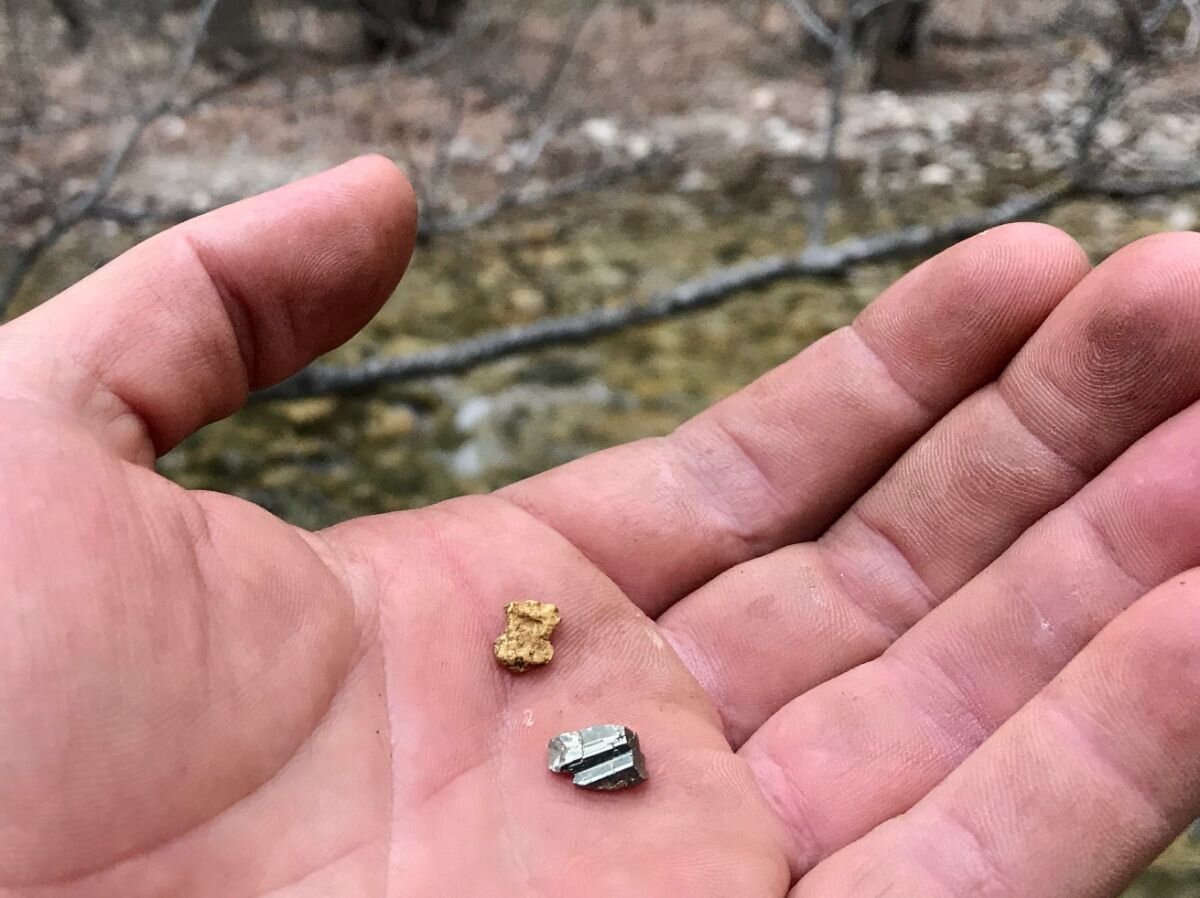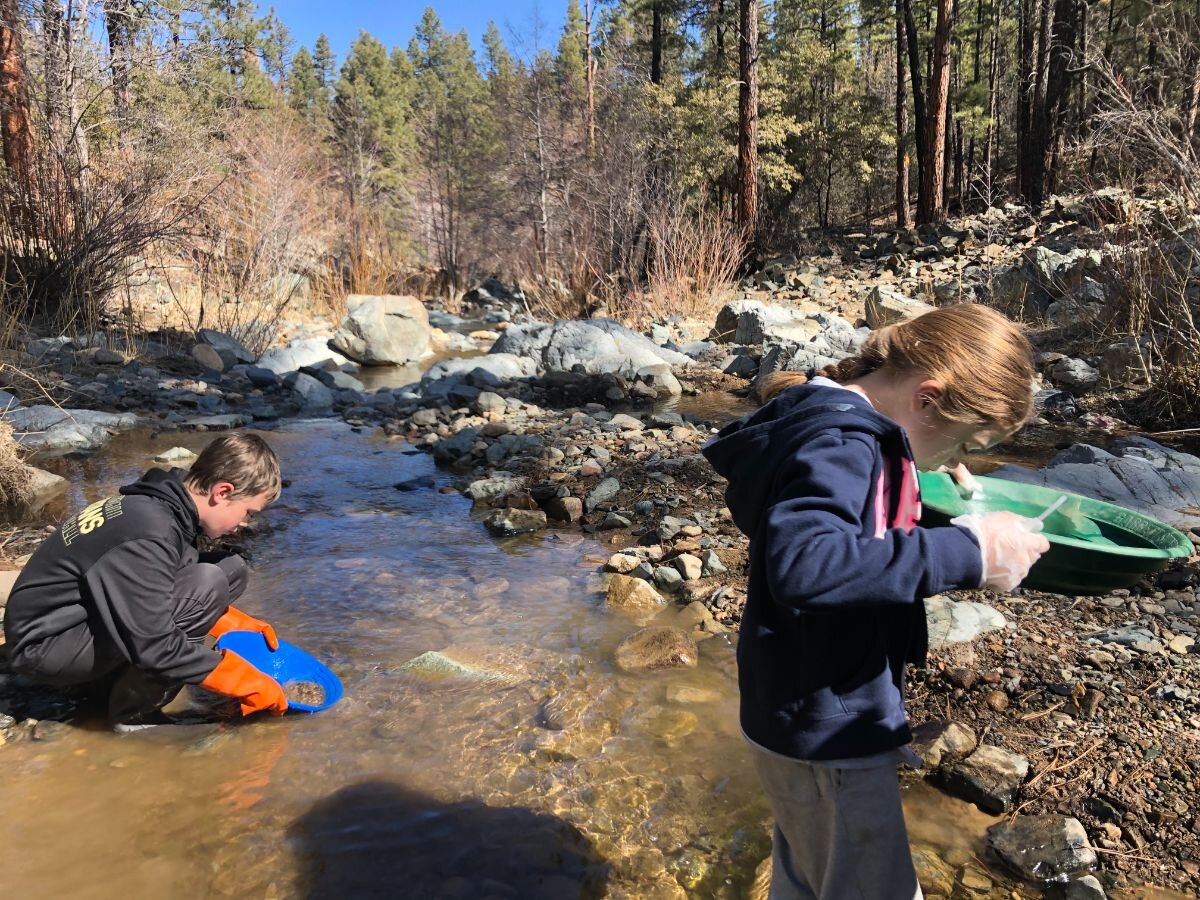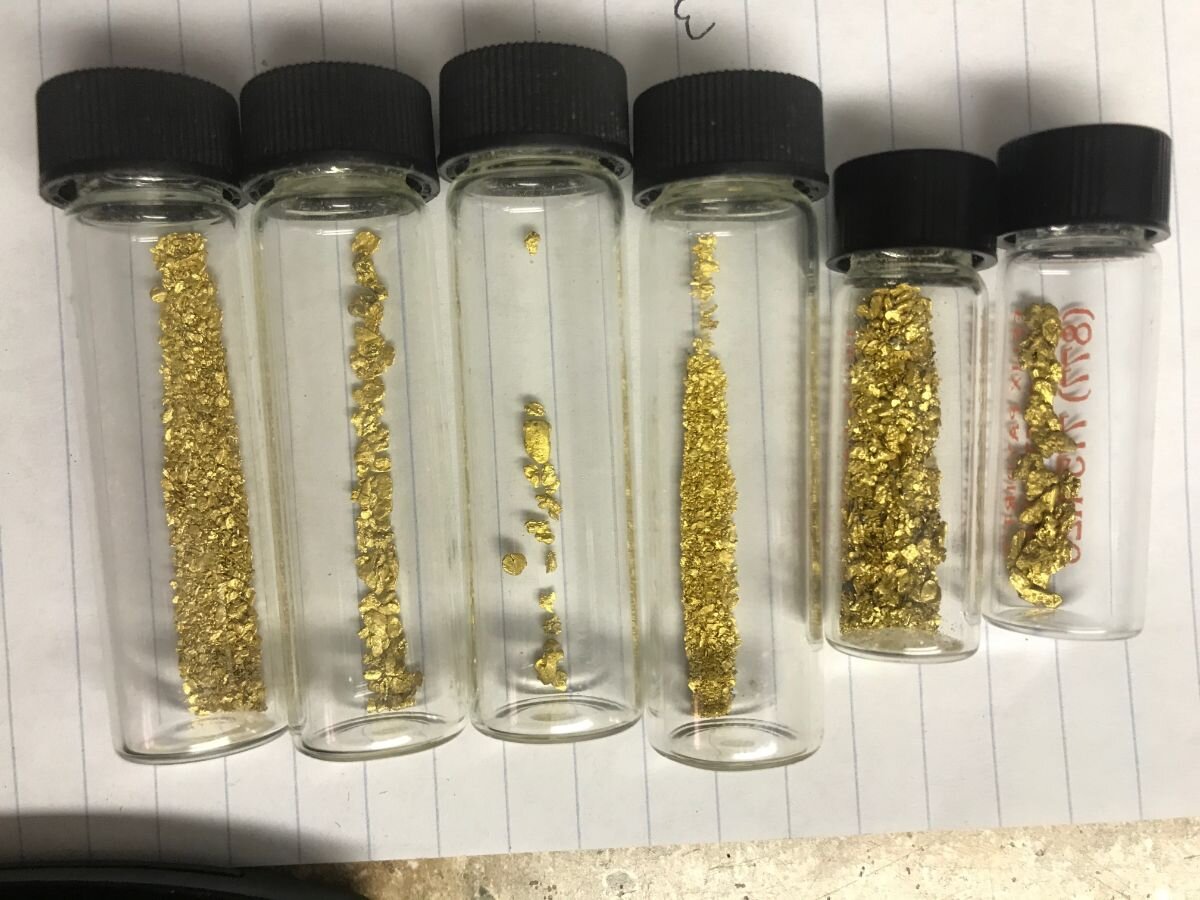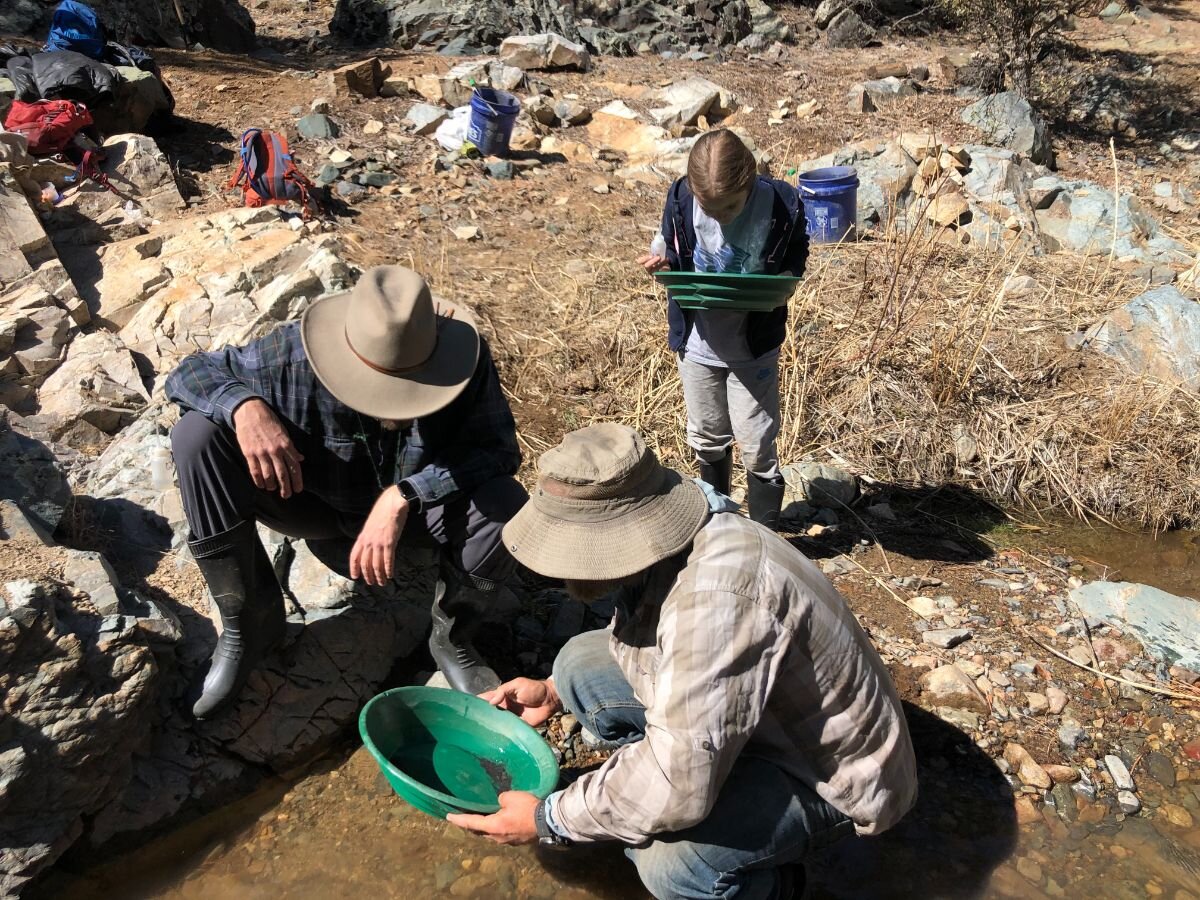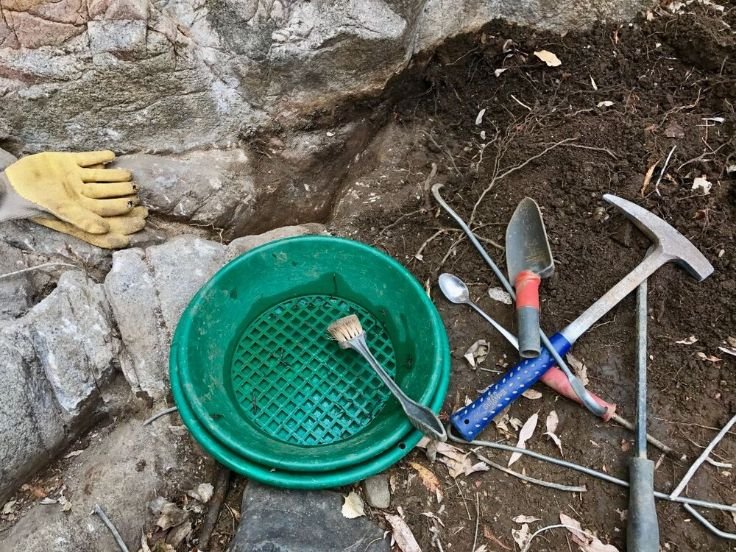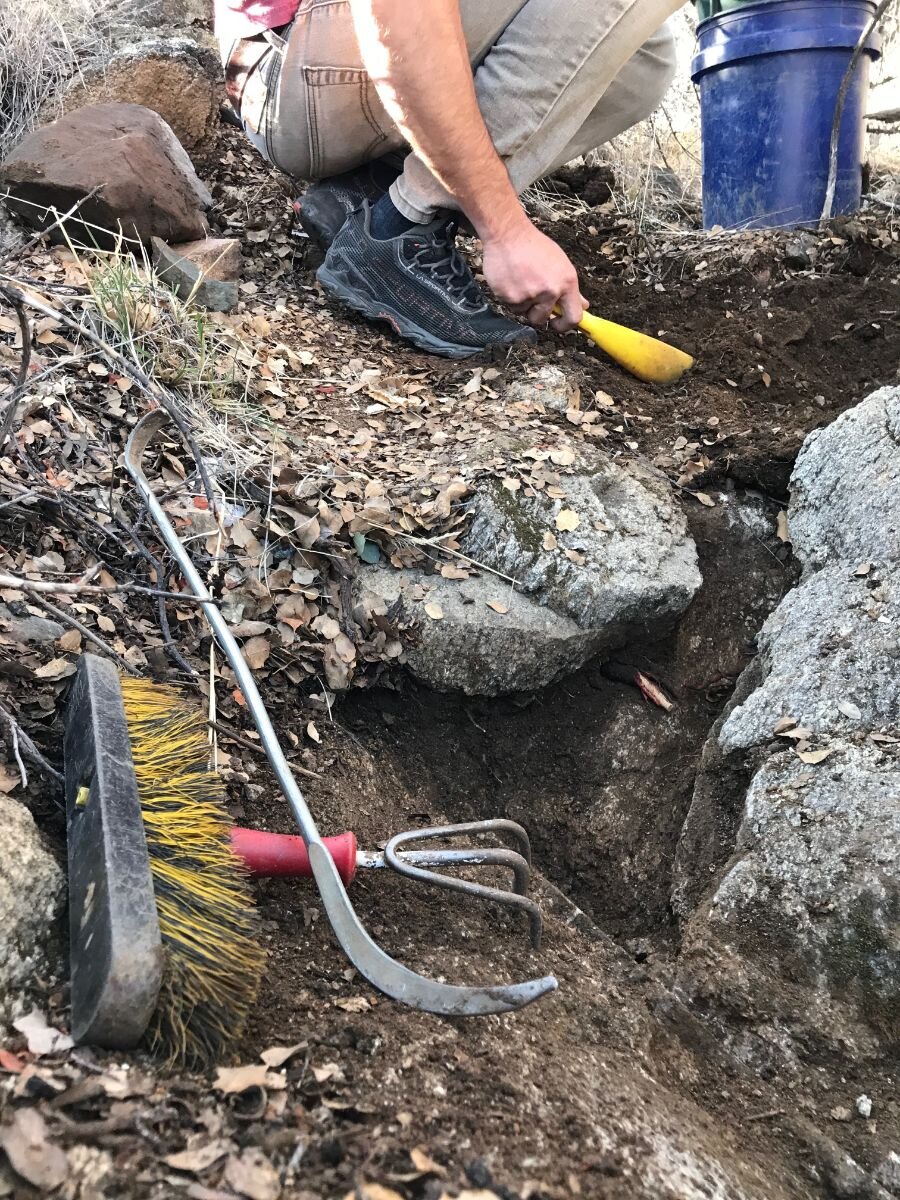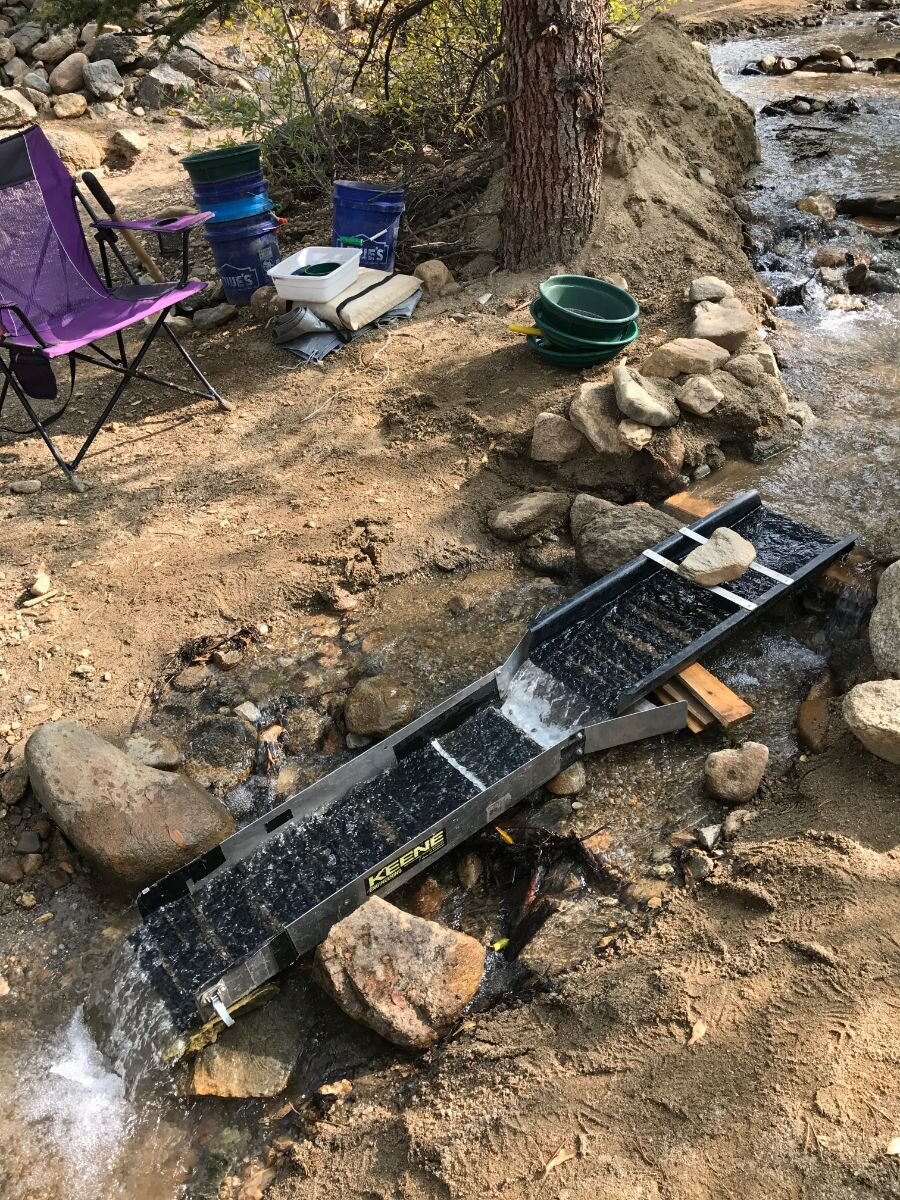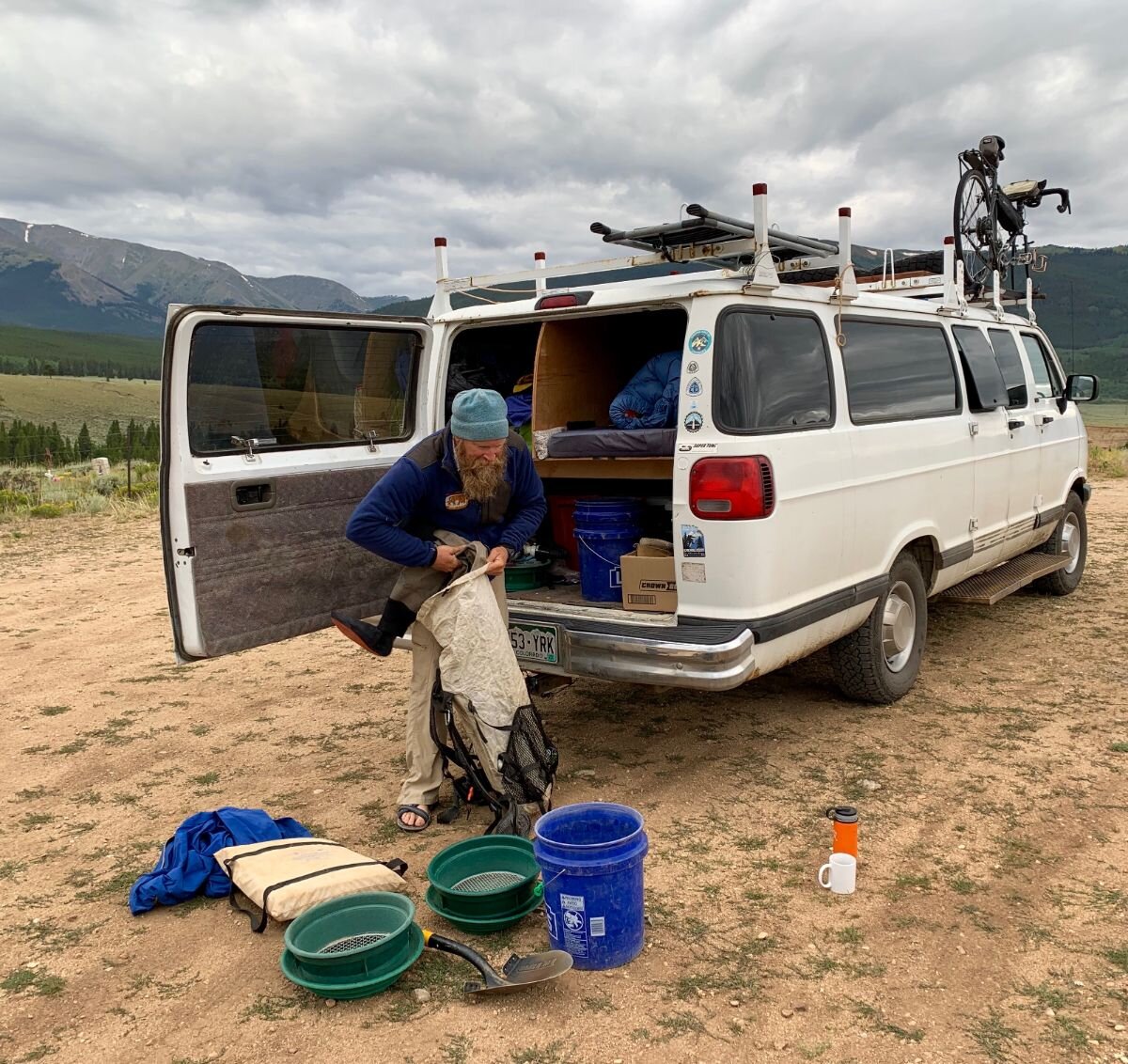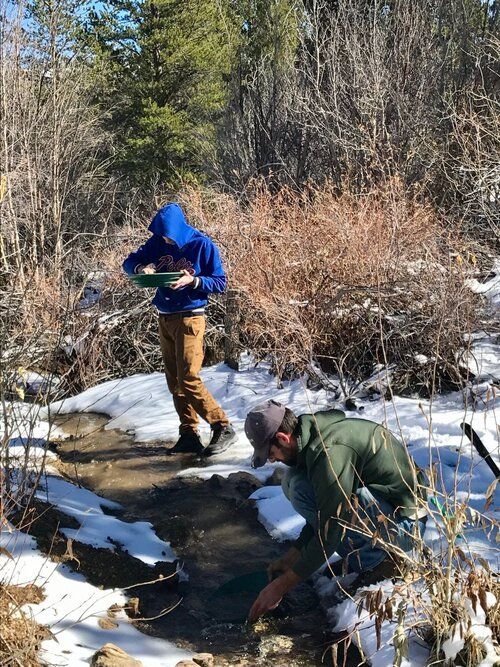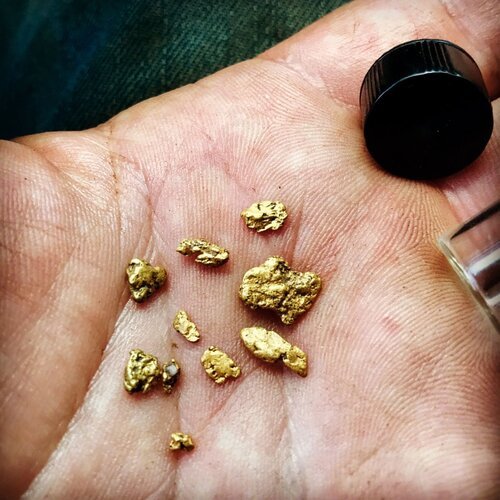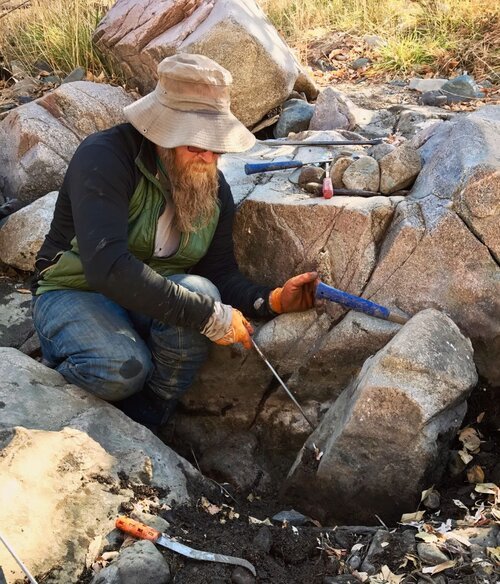How to Get Started Gold Panning and Prospecting
Equipment, Techniques, How to Find Gold, and Advanced Prospecting Tools
Treeline senior editor Brandon Lampley loves exploring the outdoors in many ways—including gold panning! Photo courtesy Brandon Lampley.
May 18th, 2023
When you tilt back the pan and become the first person ever to lay eyes on pieces of gold, well, there's nothing quite like that feeling. It's exhilarating — like a bonus for playing outside and making mud pies down at the river.
Learning about geology and our natural environment is enjoyable and rewarding and a great way to share some playtime with family and friends. I studied geology and hydrology. These days, rockhounding and gold panning—and sharing that skill with others—are two of the ways my exploratory itch gets scratched.
Now, I’m a gold panning guide in Colorado. I enjoyed crystal hunting in our garden as a kid, coming back in with a pocket full of cool rocks—and looking for gold is another fun way of spending time in nature.
I’ll help you start in your gold prospecting adventures and find your first few flakes of gold. If you already have some experience under your belt, we have recommendations for more advanced prospecting tools as well.
You don't need a bulldozer and a team of roughnecks to find a bit of gold. Prospecting has always been about a good pair of boots, a shovel and a pan, and the desire to explore. So we’ll start with the basics: where can you look for gold, what equipment gets you started, and some tactics for the hunt.
Then, we'll get a little deeper. But mainly, we're talking about finding placer gold—gold that has been liberated from the rock it was initially deposited in and moved around by water. Gold doesn't rust or dissolve, and it is really heavy relative to other rocks and minerals—so it may be easier to find than you think. You can find some using just a pan and water!
We create reader-supported, objective, independently-selected gear reviews. This story may contain affiliate links, which help fund our website. When you click on the links to purchase gear, we may get a commission, without costing you an extra cent. Thank you for supporting our work and mission of outdoor coverage for every body! Learn more.
Equipment you need for gold panning
Gold panning ESSENTIALS
| GEAR ITEM | PRODUCTS WE LIKE |
|---|---|
| Gold Pan | |
| Supersluice Gold Pan, 15" | |
| Stansport Gold Pans, 14" | |
| Shovel | |
| Fiskars Ergo Garden Trowel |
what to wear gold panning
| GEAR ITEM | PRODUCTS WE LIKE |
|---|---|
| Rubber Boots | |
| Any rubber boots | |
| Gloves | |
| Rubber dishwasing gloves | |
| Sun hat |
EQUIPMENT FOR DESERT GOLD PANNING
| GEAR ITEM | PRODUCTS WE LIKE |
|---|---|
| Drywasher | |
| Keene 140S Vibrostatic Drywasher | |
| Metal Detector | |
| MINELAB Equinox 800 Metal Detector | |
| MINELAB Gold Monster 1000 Gold Detector |
intermediate level gold planning equipment
| GEAR ITEM | PRODUCTS WE LIKE |
|---|---|
| Crevicing Tools | |
| Geologist's hammer | |
| River Sluice | |
| Keene A52 Hand Sluice |
advanced level gold panning equipment
| GEAR ITEM | PRODUCTS WE LIKE |
|---|---|
| Highbanker | |
| Gold Hog Piglet Mini Highbanker | |
| Dredge | |
| Keene 4" Dredge | |
| Mini Wash Plant |
Flour gold and a little picker, the results of a full day washing rocks in Colorado, a great result. Photo courtesy Brandon Lampley.
Where to Find Gold
Before we get to the gold-finding gear and techniques used to separate gold dust and flakes from sand and gravel, let's start at the beginning. Skip ahead to equipment if you know where you can prospect, or Top River Reading Tips if you're ready to wash rocks. We’ve also got recommendations for your first pan and river sluices and expert tips on how to put them to use.
You are most likely to find some gold where it has been found before. Let that sink in. People have searched for gold for thousands of years and done a great job finding where it lives. The good news for us? They didn't find it all—far from it—and we know which areas to look in.
There are many ways to research where gold has historically been found. Ask at a local rock and gem shop, or find a local prospecting club. Firsthand knowledge is invaluable, and contrary to what you may think, most locals are happy to give you some tips. In addition, rockhounding and prospecting clubs are great ways to meet experienced prospectors.
Everything from government geology bulletins and gold mining reports to YouTube videos is available online to aid your research.
There are even books devoted to where to hunt for gold. For example, Finding Gold in Colorado is a detailed book that can guide you to public access areas in Colorado. In addition, the website thediggings.com is a great place to research historical and currently active regions.
And the other good news? Placer gold lives in more places than you think. Many indigenous cultures across North America have fashioned ceremonial gold objects from placer gold for centuries. In the United States, the first gold rushes among non-indigenous people were in North Carolina and Georgia in the late 1700s. Spanish explorers found gold in the Southwest long before. The California and Colorado bonanzas of the mid-1800s are well known. New Hampshire and Vermont have some good placer deposits. Pretty much all of the upper Midwest has some placer gold transported by the continental ice sheet during the last glacial maximum. Yes, folks even find a little bit of gold in Iowa.
How to Find Gold On Public Land
Remember, gold is where it's been found before. If you're in central North Carolina or the Colorado or California mountains, that's darn near every creek and river. Gold has been found in more states than not.
With that being said, to dig on private land, you will need the landowner’s permission. Most hunters and anglers are familiar with asking permission to access private land. The OnX app is a perfect app to help by offering land ownership details and mapping in the field in real-time.
Colorado gold country. Photo courtesy Brandon Lampley.
Is it Legal to Prospect for Gold?
Public land prospecting access requires some investigation. Some cities and counties allow recreational gold prospecting. You can pan for gold in the majority of metro Denver, for example.
Generally speaking, federal land, both US Forest Service and Bureau of Land Management, is open to exploring, with one huge caveat. You must respect mining claims on federal public land; they should be signed (read more about mining claims here). The BLM’s new Mineral & Land Records System is the definitive source of mining claim records.
Some federal public land is mineral withdrawn, meaning no claims are allowed, but recreational mineral exploration is. These ‘open for prospecting’ withdrawn areas in historic gold mining districts are excellent areas to search. Research pays off.
Just enough water for panning at the Lynx Creek mineral withdrawal area in Arizona. Only pans and shovels are allowed. Photo courtesy Brandon Lampley.
Rockhounding or Panning Parks
Another option is to prospect at rockhounding or panning parks—public land explicitly set aside for recreational gold prospecting. Some examples:
Arapaho Bar Gold Panning Park near downtown Denver is a popular spot to learn.
In 2013, the City of Wheat Ridge formally allowed recreational gold panning in the creek, and it’s free.
The majority of the Uwharrie National Forest in central North Carolina is open to gold panning (visit the ranger station for detailed maps).
The Lynx Creek withdrawal area outside Prescott, Arizona, is another popular area open to gold panning.
It’s been over 160 years since the end of the California Gold Rush. However, Marshall Gold Discovery State Historic Park in Coloma, California, still allows gold panning along the South Fork American River.
Each public access area regulates what mining equipment can be used; familiarize yourself and follow the rules.
Family prospecting day at Cache Creek in the Colorado high country. Photo courtesy Brandon Lampley.
Gold pan on private land or with a guide
Many small mines and recreational panning businesses are located in gold districts. And many prospecting clubs have free outings to introduce new prospectors to the hunt. Some examples across the country are listed below:
Reed Gold Mine in North Carolina is a state historic park near the discovery of the 17-pound nugget that launched the first gold rush.
Vic's Gold Panning in Blackhawk, Colorado. A private mine where you can pan near the ‘richest square mile on Earth.’
The GPAA, Gold Prospectors Association of America. This organization is composed of a hundred or so local clubs, whose meetings are free to attend. Most arrange outings.
Paystreak Gold Panning & Prospecting Adventures in Morristown, Arizona
Gold Daughters, Gold Panning Tours in Fairbanks, Alaska.
The author of this How-To offers guided prospecting trips through Colorado Gold Guide.
A chunk of fool’s gold (iron pyrite) on the lower-right beside a nice little gold nugget (on the upper left). Once you've seen gold, nothing else looks quite like it. Photo courtesy Brandon Lampley.
Fool’s Gold vs. Gold: How to Recognize Real Gold
Once you've seen gold dust and flakes, it is easy to recognize. But what about your first discovery?
First, gold is heavier than any other material in your pan. It will be the last thing to move when gently moving your concentrates with water. Second, most placer gold is 18 karat or considerably more pure and far more colorful than common jewelry alloys.
But what about that Fool’s Gold? Fool’s gold is a common name for iron pyrite, a brassy-looking metallic mineral. While placer gold is usually worn smooth and malleable, pyrite fractures at sharp angles and shatters under pressure. Muscovite-type mica is also often mistaken for gold. It has a pleasing honey color but is relatively light and fractures into paper-thin flakes. Have something in your pan that sparkles in the sun? It’s likely mica since gold doesn't change in appearance from the sun to shade.
Find someone to show you a pan with gold dust and little flakes. Ask a prospector at the river. Visit a store. Buy a bag of paydirt with guaranteed gold. Once you've seen it, you’ll know.
A sign indicating a federal mining claim. Photo courtesy Brandon Lampley.
Where to Dig for Gold and Gold Panning Ethics
When picking an area to dig, we have a few responsibilities as miners. First, respect private property, and follow the regulations on public land. Respect active mining claims.
As gold prospectors and rockhounds, we must consider our impact on the natural environment. As mentioned earlier, do your research to verify prospecting is allowed where you choose to dig.
Fill in your holes at the end of the day, and leave your area cleaner than you found it. Carry a trash bag for yourself and any refuse left by others.
In rivers and creeks, dig below the high watermark and avoid digging around roots or any other vegetation that helps stabilize the riverbanks.
Familiarize yourself with Leave No Trace guidelines, and practice them whether you’re out for an afternoon or camping overnight.
Know the regulations regarding historical relics, artifacts, and archaeological resources.
I cleaned a deep hole and crack under a small dry waterfall this day and found a little nugget. Lots of lead in this low-pressure trap as well. Photo courtesy Brandon Lampley.
How to Read a River
Most of the time, for gold to move, flood-level water flows are necessary. Therefore, gold will get picked up during a flood and stop moving in somewhat predictable areas with lower water pressure.
Gold is very heavy—19 times denser than water—and is deposited along with other heavy minerals. That’s why many prospectors look for the heavy minerals of black sand—gold often accumulates where the black sand deposits are most concentrated.
A rule of thumb is that most black sand is about five times heavier than water, while most light-colored rocks and sand are only three times heavier. Gold, as mentioned above, is 19 times heavier than water. Iron scrap like nails and lead shot? These are 8 and 11 times heavier than water, respectively, and great indicators for nearby gold. Look for areas where any and all of these indicators drop out of the flood flows.
The Arkansas River in Colorado is a place to look for deposits. Photo courtesy Brandon Lampley.
How to Find Common low-pressure deposit areas
Here are other tips for finding common low-pressure gold deposit areas. These tips apply at the macro and micro scales, from rivers to smaller creeks.
Look for areas where the stream gradient changes from steep to shallow or where the water flattens out and slows.
Look where the river bed widens after a narrower area. These areas are where heavy minerals drop during flood flows.
Look for inside bend deposits. Slower water found on the inside of bends creates eddies (or small whirlpools) where heavies drop.
Look around, and especially behind, large rocks in the river’s flow.
Look for bedrock exposures. Heavy minerals like gold sink to the bottom over time. Any areas of bedrock form a floor where gold can accumulate.
Look for cobble bars (gravel areas along the water’s edge with limited plant life due to regular flood flows). Look for larger cobbles and dark rocks. Test the top foot or so of gravel in between the larger cobbles.
This is a good and concise article with photos that describes many of these geologic and hydrologic features to look for.
As long as enough water is present to pan, prospecting in low water season offers greater access to potential deposits than during higher water seasons. However, be very careful around the river during high flows.
When the water is low enough, pan the top six inches of gravel in the lowest part of the main water flow, aka the “gut” of the creek. I've had much success with this tactic. It also works well in seasonally dry desert washes.
A pan and a shovel get you started on the hunt. Photo courtesy Brandon Lampley.
How to Gold Pan
Precisely because gold is very heavy, we can recover it with a pan. Shovel up some gravel and sand, use a classifier screen to remove big rocks, shake the remaining material around with water in your pan, let it settle, and wash away the lighter stuff on top. Whether you shake side-to-side or swirl is a matter of choice. What is important is that the final shaking ensures the gold is at the very bottom and that you let the pan full of material become settled and stationary before washing away the lightest material on top.
Repeat the shake and wash away process until only a few spoonfuls of heavy minerals remain. This will be all black sand and heavy little rocks in most areas, usually black with some green and purplish ones. Gently swirl the water around to reveal the gold, and suck it up with your snuffer bottle.
Lead is also very heavy. You’ll often find lead fishing weights and bullets where rivers deposit heavy materials. One old trick to help gain confidence panning—drop five or ten lead BB’s in a pan full of river material. Then, pan as usual and verify you still have all your lead bbs. Flatten these lead pieces with a hammer to more closely mimic gold flakes if you want.
Here's an entertaining video from Jeff Williams that covers the basics and more.
Gold Panning Equipment Basics
We've already learned the most important thing about gold recovery—this metal is very heavy. Water is our friend for separating heavy gold from all lighter soils, sand, and gravel. Shake a pan full of material with water, and the heavy stuff goes right to the bottom.
You can detect larger pieces of gold with certain metal detectors because gold is also a great conductor of electricity.
What equipment you will need to use depends on what type of gold you are looking for, where you are looking for gold, and how much money you want to spend upfront.
How much does it cost to get into gold prospecting?
Gold prospecting equipment can cost anywhere from $50 to more than $2,000. The following gold prospecting checklist is a rundown of what you’ll need, with options ranging from a minimalist set-up to a high-tech kit.
The tools to get started are simple—a gold pan and a shovel. That’s it. A few more accessories make it easier. Of course, you’ll also want a little vial for your finds!
If a single purchase kit appeals to you, the Garrett Deluxe Gold Pan Kit is our recommended set.
Here are our recommended individual items.
Metal pans are mostly a relic of the past. Green or blue plastic pans are a great contrast color to the black and yellow colors we seek. Both of our recommended pans are large but work well even in small hands. Photo courtesy Brandon Lampley.
Equipment to Gold Pan
GOLD PAN
We recommend the Garrett Super Sluice gold pans. The Super Sluice is a big pan, preferred by many prospectors. It comes in green, which contrasts against the black and yellow colors we’re likely to find in nature. The Proline is a bit smaller and available in blue.
The color of your pan is a personal choice, but both blue and green are good contrast colors to black sand and gold flakes. If you plan on buying multiple pans, try both colors.
SHOVEL
Any #2 spade works. Some prefer an inexpensive and light shovel. Others want a heavy and durable one, depending on how far you plan to carry it. The Fiskars options are super durable, albeit a bit heavy. Smaller shovels are nice for smaller hands and kids.
CLASSIFIER
A classifier is simply a screen used to separate large stones from the material you want to pan. We recommend ½ inch for dry material and ¼ inch for wet classifying. It’s best to start with a ¼ inch classifier and work the material near the water. As you learn and perhaps want to process dry material that you’ll carry down to the water to pan, the ½ inch is preferable.
If you can find them, the Keene models are durable and fit right on the top of a 5-gallon bucket. They also fit nicely on either of the large size pans we recommend.
FIVE GALLON BUCKET
Easy peasy. A couple of dollars at the hardware store, or free from a restaurant or construction trade friend. Once you've found a good spot, classifying material in bulk into the bucket saves time.
Placer in glass vials, separated by location found and size. The easiest way to dry your gold is to let it sit in a pan in your home overnight and air dry. Then, use a small funnel or folded paper to add it to your vial.
ACCESSORIES
You’ll need a way to store that gold you find. The snuffer bottle is for sucking up gold while panning, and the following items for moving it to a little vial later.
If you purchase a panning kit, it will likely include a snuffer bottle, pipette, and vials.
Some panners in areas with bigger flakes use a pair of tweezers.
Since most black sands are magnetic in many areas, a magnet can also help with the final separation.
Sun hats are essential equipment for gold panning. Photo courtesy Brandon Lampley.
What to Wear Gold Panning
Clothing
RUBBER BOOTS
Simple rubber boots are excellent for standing on the river’s edge.
GLOVES
A thin pair of fabric gloves with a rubber-coated palm and fingers work great. Waterproof dishwashing gloves are helpful if the water is cold.
SUN HAT
Protect your head and ears from the sun. You can use a hiking sun hat or a running sun hat. A cowboy hat works great too. Just wear something to protect your head and cut down on glare from the water.
POLARIZED SUNGLASSES
Rays that bounce off the water are a concern. Wear some good sunnies. We like Native Sunglasses as they are lightweight, polarized, and have great peripheral coverage. Another perk is that the arms are metallic, which is relatively rare these days in sunglasses and we’ve found handy for durability. For a less expensive option, we like goodr sunglasses, which are designed to be no-slip, no bounce, and polarized. See our recommendations on polarized sunglasses and how they work here. You can read all about sunglasses we like for running—they also work great as general sport sunglasses for being active outside).
Cracks in the bedrock, aka crevices, are a natural gold trap. Scrape out as much material as you can; the gold will be at the very bottom. Photo courtesy Brandon Lampley.
Next Steps: Intermediate and Advanced Gold Prospecting Equipment
You'll be fine prospecting with our minimalist kit, but if you want to make a more significant investment or are finding a lot of bedrock, here’s some other equipment you may consider. But, of course, it all starts and ends with the pan — master that first.
Crevicing Tools
If you find a lot of bedrock where you explore, you’ll want to buy some crevicing tools to clean out the cracks where gold gets stuck.
A metal spoon, flat screwdriver, and toothbrush serve well to start. Also, a geologist’s hammer and a few purpose-designed crack scraping tools are helpful.
Gold prospecting crevicing tools. Photo courtesy Brandon Lampley.
A river sluice allows you to process more gravel and sand than a hand sluice. Photo courtesy Brandon Lampley.
River Sluice
If your goal is to find gold flakes and you’re willing to process a lot of gravel and heavy black sand, your next step will be getting a river sluice. A river sluice allows you to wash more material. When using a sluice, or the powered equipment below, it is common, but not necessary, for two or three folks to work together.
A river sluice is placed in the streamflow and fed classified material with a small scoop or shovel. The sluice separates the heavy minerals with water action similar to panning but happens more quickly. The captured concentrates are then panned to recover the gold.
Plastic composite drop riffle sluices are light and inexpensive. I prefer a light weight sluice that has makes it easy to clean out the concentrated heavy minerals. You’ll want to clean out this sluice immediately after stopping to feed it; this only takes a few seconds!
Keene A52 River Sluice
The Keene A52 River Sluice is a traditional sluice that uses metal riffles and a combo of miner’s moss and carpet to capture the heavies. While the Keene A52 river sluice is much heavier, more time consuming to clean out, and more expensive, it can be left in the flowing water without constantly feeding material into it.
The Gold Hog Piglet with a stream sluice extension. The perfect first wash plant, the Piglet works well powered by either a battery and DC pump or a small gasoline engine.
What Passionate Gold Prospectors Use
Most public access areas allow the use of hand tools only. Some areas allow the use of a river sluice. A few areas allow battery-powered mechanical equipment to process more material. Here are suggestions for your first small wash plant once you have access to grounds where powered equipment is permitted.
Highbanker
A highbanker is essentially a miniature version of the types of wash plants used by commercial-scale placer miners. With a highbanker, you can wash more rocks because you usually shovel unclassified material right in.
The Gold Hog Piglet is an excellent unit for one to two prospectors working together, shoveling right into the highbanker, and perfect for a family. Adding an extension to the sluice box is desirable for areas with lots of tiny gold, called “flour” by prospectors. In many regions, regulations require a deep cycle battery and 12 volt DC bilge pump to power the Piglet.
If you can use gasoline-powered equipment, upgrade to the Gold Hog Raptor, and add a 2.5- or 3-inch dredge conversion to feed the box.
Dredge
A dredge sucks material up right from the river bottom. In shallow water, you can long arm or hold the suction nozzle while standing in the river. In deeper water, diving equipment is used. Dredging is an advanced technique of gold recovery that many aspire to use.
A battery-powered Gold Cube with trommel attachment. It’s a top notch piece of equipment for finding flour gold. As you can see, folks with a lot of gold recovery equipment often find a burly wagon useful.
A Keene 4 inch dredge is a great introductory unit. Keep in mind that many states restrict the size of a dredge to four inches and ten horsepower for the engine (larger dredges will incur significant permitting costs).
mini wash plant
A very popular new style mini wash plant, the Gold Cube is multipurpose. Add the trommel (screening) attachment for use at the river shoveling straight in. Or use it at home with a recirculating system to clean up your dredge or highbanker concentrates. The Gold Cube is best used as an electric-powered unit with a deep cycle battery and bilge pump.
Early morning material processing with a small drywasher powered by a leaf blower engine. Drywashing can be noisy and dusty; a mask is a good idea.
How to Gold Prospect IN THE DESERT
Searching for gold with a pan and water is the easiest and most affordable entry into the hobby. But there’s lots of gold in dry and desert areas too! You can, of course, carry some water and a panning tub while you’re out exploring in the desert. That's the best way to verify that/whether gold is present where you are. But processing at a larger scale in the desert would require bringing lots of water. Hence, two tools are the standard equipment of the dedicated desert prospector: a drywasher and a metal detector.
Drywasher
A drywasher is quite similar to a highbanker (which I discussed above). You can shovel right into it, but it uses air and vibration to blow away lighter material rather than water to wash it out.
The Keene 140 Drywasher is a popular small-scale unit appropriate for a couple of people working together and includes a vacuum capability for crevices and bedrock.
One gram nugget found with the Minelab Equinox 800. The Nox is ideal for folks who detect for gold and coins in parks and beaches.
Metal Detector
A metal detector is another popular way to search for gold without water, but it is challenging. The overwhelming majority of placer gold is too small to ring up on even the best detectors. This equipment is best used to search for pickers (a piece large enough to pick up with your fingers) and nuggets.
The Minelab Equinox metal detector is a favorite for folks interested in taking their search for gold to the next level. Photo courtesy Brandon Lampley.
Larger chunks of gold make a gold detector scream. I've found a few nice little nuggets with my detector. As I'm writing this today, I've spent about 15 hours swinging my metal detector since I found my last little gold nugget. Is it frustrating? Yes, but I've explored some pretty awesome terrain. I've dug a silver coin from the 1800s and a few cool artifacts from the same era. With panning, you’ll find lots of gold dust—nearly every day. When detecting gold, finds are less frequent but larger.
Our recommended detectors for beginners are relatively affordable, very low frequency (VLF) units rather than the much more expensive pulse induction (PI) gold detectors.
Minelab Equinox 800
The MINELAB Equinox 800 is the best general use VLF detector out there, the MINELAB Equinox 800 is appropriate for folks who also hunt for coins and relics. In addition to the standard kit, I recommend adding the smaller 6-inch coil for gold hunting. This smaller coil is more sensitive to pickers and easier to swing over bedrock and in tight spaces.
Minelab Gold Monster 1000
The MINELAB Gold Monster 1000 is a similar VLF machine, the Gold Monster’s interface is largely automated, and the frequency is optimized for gold detecting. I recommend this unit for prospectors seeking a dedicated gold detector at an entry-level price.
The author and his prospecting adventure van. Photo courtesy Brandon Lampley.
Gold Prospecting vs. Gold Mining
Prospecting means finding where the gold is. Mining considers and plans how to efficiently process more dirt, and hopefully recover more gold. I like to emphasize to new folks that there is a distinction between gold mining and prospecting. Traditionally, prospectors searched out new gold deposits and often benefited by selling that information to larger groups of miners or mining companies.
This distinction is important. Use systematic prospecting to find the best concentrations of gold; it may take many days to find a spot worth the effort of highbanking or sluicing. I know it's tempting to want to use the highbanker or sluice as soon as you get to the river—but resist the temptation. You'll be a lot happier and get more gold by doing some legwork first.
Gold panning in the snow in Colorado. Photo courtesy Brandon Lampley.
Strategies for Finding Gold
For beginners, think of prospecting in multiple parts.
First, prospecting is your research related to where to go (see section above).
Then, it’s the tactics for digging likely dirt.
At the creek, I'll sample pan in 10 to 20 locations during my first visit. Even when one of the first pans shows gold, keep moving— you may find better spots. At the locations of my three best test pans, I'll classify and sluice one or two buckets of material. That larger sample should be more representative. This systematic sampling is a rewarding experience.
Sluicing a bunch of buckets in a day, or setting up a little highbanker, should be considered recreational mining. You want that effort to be applied to the material you've personally tested and where you have judged the mining to be worth the effort. The same applies to panning in the same spot all day—make sure it's a good spot!
A similar train of thought applies to metal detecting for gold. Swing over a variety of ground on your first visit to an area. Take your time, check bedrock in the creeks or washes, and bench material where you see it. When luck is on your side, and you've detected a piece of gold, now think about mining that area. I use some rocks or sticks to mark out a spot—usually about five by ten paces. I'll then take my time to detect that ground thoroughly, swinging from two directions. If you find multiple pieces of gold, mark the locations. Observe if there's a trend.
I'll be keeping these pickers and nugget. They represent a season of exploring new ground. I know exactly where each was found and remember the days well. Photo courtesy Brandon Lampley.
Expectations for Finding Gold
Gold prospecting is an enjoyable hobby that gets you playing outside and exploring. That being said, very very few people find enough gold to pay for their mining equipment or even cover the cost of food and transportation for a day playing in the river. I encourage you to think of the gold hunt as a hobby rather than a source of income. Placer gold can be sold quite easily, usually for 70-90% of commodities market spot price. Remember, placer gold isn't pure gold, and refiners need to make a profit margin. Most prospectors keep all of the gold they find.
After many years of exploring, my passionate prospector friends are quite happy any day they find one gram of gold. Most days panning or sluicing produce less. Multigram days are rare without processing far more material than most recreational prospectors can wash.
What are some cool goals you can set for your own gold findings?
A Ring. About ten grams of placer gold will make a wedding band-style ring. Many prospectors work towards this goal.
Enough gold to buy new equipment. While possible, most folks prefer to keep their hard-earned gold and invest in more equipment.
Pickers. Any piece large enough to pick up with your fingers counts. Depending on where you search, pickers are not uncommon.
A Nugget. A lifetime goal? How big a piece has to be for it to be counted as a nugget is a matter of opinion. I'm psyched about my one-gram nuggets!
The author using refined techniques. Photo courtesy Brandon Lampley.
Refining Your Technique
In many areas, you'll cross paths with other gold panners out in the field. A friendly hello can often lead to some valuable knowledge. Observe how the old hands work their pan. In addition, gold panning how-tos are a popular YouTube topic. Many regions have prospecting clubs.
Purchasing paydirt and processing it to recover the gold is a popular new pastime. Don't expect to make money on your paydirt investment. But consider it a great way to practice, especially if you live somewhere with minimal or no natural gold. Seek out paydirt sellers who sell actual concentrates from placer mining.
Have fun out there, and test lots of spots to find your gold. Keep your curiosity active, make some new friends, and keep swirling that pan. It all adds up!
Why You Should Trust Us & About the Author
Brandon Lampley is an all-around outdoor enthusiast who comes to Treeline Review from Outdoor Gear Lab, where he was Senior Editor. Brandon has summited Denali and Ama Dablam and pioneered first ascents in the Indian and Chinese Himalaya. His bigwall climbs include several El Cap routes in Yosemite. He’s spent a month kayaking the Sea of Cortes, bike toured across the U.S. several times, and thru-hiked the Pacific Crest Trail and the Appalachian Trail. For three years, Brandon lived and worked in Phortse, Nepal as the project director of the Khumbu Climbing Center where he worked alongside Nepali climbers to increase safety for high-altitude climbers and workers. When he’s not on a long trip or traveling, Brandon lives in his van exploring the U.S. and has biked and climbed in 48 states and 20+ countries. Most recently, he can be found gold-panning in the mountains of North Carolina. He holds degrees in Environmental Science, Geology, and Psychology from Duke University.
You can read more about Brandon and see his other articles on his author page.

